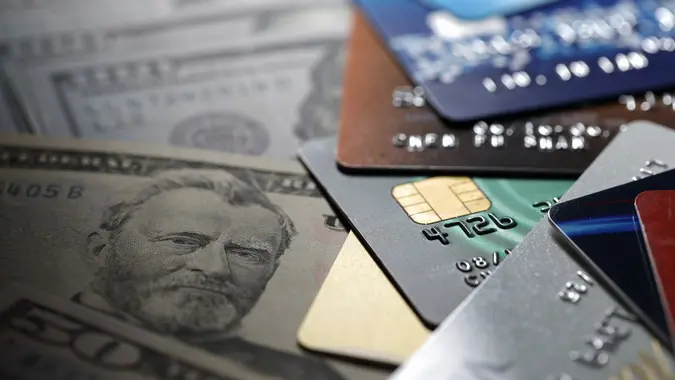3 Ways Balance Transfers Help You Manage Debt and Save Money

Commitment to Our Readers
GOBankingRates' editorial team is committed to bringing you unbiased reviews and information. We use data-driven methodologies to evaluate financial products and services - our reviews and ratings are not influenced by advertisers. You can read more about our editorial guidelines and our products and services review methodology.

20 Years
Helping You Live Richer

Reviewed
by Experts

Trusted by
Millions of Readers
Carrying credit card debt can be very tough on your finances. If you’re struggling to keep up with payments, you’re not alone. According to Ramsey Solutions, it’s estimated that 103 million Americans carry credit card debt at some point during the year, which is approximated from the fact that 82% of adults have at least one credit card, and 47% of those cardholders carry a balance at least once a year.
Therefore, opening another credit card when you’re already in debt might not sound wise, but a balance transfer actually can be a smart move depending on your situation. Here are three ways a balance-transfer card can help you manage debt — and how much money it can save you.
You’ll Pay Less in Interest Charges
If you have a substantial credit card balance and a high annual percentage rate (APR), a considerable part of your monthly payment is going toward interest. This makes it tough to even put a dent in your balance, let alone pay it off entirely or save money every month.
Balance transfer offers can make a huge difference. Moving your balance to a card with a low or zero APR will allow you to pay less in interest over a significant period of time (usually a year or more), so you have more money to put toward the principal. The average APR is approximately 21.5% to 24% for existing accounts carrying a balance with interest, which can quickly lead you into a debt cycle.
You Can Consolidate Credit Card Debt
Trying to pay down debt on one credit card is difficult enough. Things just get even more overwhelming when you’re paying off multiple cards.
Opening a balance-transfer card can help, because you can consolidate your debt into one monthly payment. This will be much easier to manage and will lower your risk of late fees — and you should end up paying less interest overall.
Make sure you research the best time to sign up as many companies offer introductory periods or promotional periods that come with financial bonuses for new customers.
You Can Pay Off a Large Purchase Over Time
Sometimes you need to make an expensive purchase, but you don’t necessarily have the funds on hand to cover it. Maybe your washing machine breaks unexpectedly, and you don’t have the cash to replace it.
A balance-transfer card can help make this expense more manageable, because you can make payments without racking up excessive interest fees. Just transfer the balance to your new credit card and calculate the amount you’ll need to pay each month to resolve your debt before the end of the introductory APR period.
Final Take To GO
Credit card interest can add up fast, significantly increasing your total balance. If you want to stop spending money you don’t need to and start putting it back into your savings account, then it’s time to consider balance transfer options. Paying off your debt more quickly thanks to a lower APR and consolidating your debt means you will ultimately pay less and save more when you opt for a balance transfer card.
Caitlyn Moorhead contributed to the reporting for this article.
 Written by
Written by  Edited by
Edited by 

























